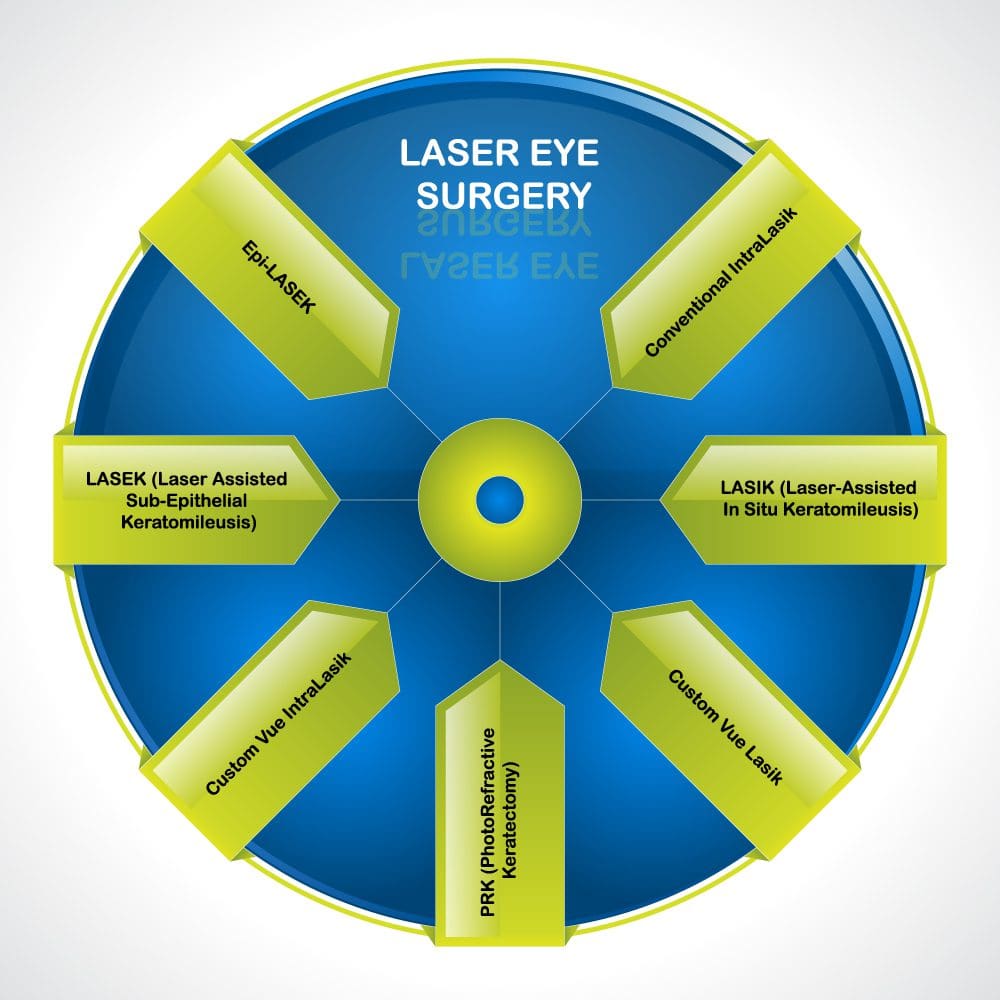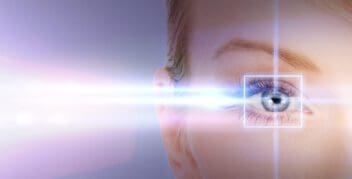
Medically Reviewed by Tom Tooma, M.D., Founder/Medical Director
Custom LASIK: Advantages and Disadvantages
Home / Laser Eye Surgery Guide (Updated) /
Last Updated:

Medically Reviewed by Tom Tooma, M.D., Founder/Medical Director
The LASIK procedure has helped millions of people around the globe improve their vision by correcting common refractive errors, like nearsightedness, farsightedness, and astigmatism.
Custom LASIK uses a computer called a wavefront device to measure your unique corneal shape, examining aberrations and calculating how to improve your vision while maintaining the original overall shape of the cornea. In contrast, traditional LASIK is programmed based on the prescription of your glasses or contact lenses, which does not take your corneal aberrations into account.
Most people report fewer side effects, especially light distortions and night-driving issues, with custom LASIK. It is more expensive and not covered by insurance, however. Still, custom LASIK could be a good option for you, so discuss this possibility with your eye doctor.

What Is Custom LASIK?
Laser-assisted in situ keratomileusis (LASIK) is a type of vision-correcting surgery that uses guided lasers to reshape the cornea of the eye. This refracts light correctly back onto the retina, creating a clearer image of the world.

LASIK, which was approved by the U.S. Food and Drug Administration in 1998, is the most popular type of outpatient surgery for refractive errors, like nearsightedness, farsightedness, and astigmatism.
You deserve clear vision. We can help.
With 135+ locations and over 2.5 million procedures performed, our board-certified eye surgeons deliver results you can trust. Your journey to better vision starts here.
By using guided lasers, LASIK removes small amounts of the cornea to reshape it. Once light is refracted properly onto the retina, this results in clear vision without the need for glasses and contacts.
- You qualify for custom LASIK if you meet these criteria:
- You are 18 or older.
- You have no history of eye diseases that may affect the outcome or safety of the procedure.
- You have a corneal thickness that is appropriate for the procedure.
- You have mild to moderate nearsightedness, farsightedness, or astigmatism. LASIK is approved for the correction of up to -12.00 of nearsightedness, and up to 6 diopters of astigmatism and farsightedness.
- You have a normal corneal contour (topography).
- You have a stable refractive error, defined by the FDA as having less than or equal to a change in prescription of 0.50 diopters over a one-year period of time.
How Wavefront Devices Assist in the Custom LASIK Procedure.
Since the development of LASIK, medical researchers have worked to continually improve this low-risk, highly effective elective procedure. One of these innovations is wavefront LASIK, often called custom LASIK.

When someone refers to wavefront LASIK, they refer to a specific process called wavefront-guided technology used by eye surgeons to correct all the optical imperfections (higher order aberrations) in the entire optical system, which includes the cornea and the lens of the eye. Traditional LASIK uses your prescription in your glasses (refractive error) to program the laser.
The addition of wavefront computer imaging means that your corneas will be even more specifically shaped, increasing your chance of having 20/20 or better vision. Therefore, the process is sometimes called custom because it is customized to your eye’s needs.
The measurement is called wavefront because it uses reflected light waves to measure aberrations, from lower-order to higher-order, in your eye. The device will transmit a safe, non-UV light wave into your eye, which is reflected off the back surface of the eye (the macula and retina) and out through the pupil.
The wavefront computer, or aberrometry device, measures that reflected light wave to create a unique pattern, which displays how your cornea is shaped, along with some other features of the eye itself. The measurement of your cornea’s irregularities will look like a topographical map.
Advantages of Custom LASIK
There are several potential advantages to custom LASIK compared to traditional LASIK. The greatest is that traditional LASIK does not measure your specific corneal aberrations, the hills and valleys on your corneal surface that we are all born with.
Our corneal contour is unique to us, much like our fingerprints. Wavefront technology allows your eye surgeon to customize where the lasers will remove tissue from the cornea, taking your cornea’s individual shape and irregularities into account.
Custom LASIK improves not just the clarity of your near and far vision, as measured by the Snellen chart, but it can also improve other qualities in how you see, such as contrast sensitivity and fine vision. Improving other aspects of your vision can reduce some of the side effects associated with traditional LASIK, especially difficulty with night vision.
There are potential side effects associated with LASIK, both traditional and custom. Most are temporary, such as dry eyes, halos and glare at night, a scratchy feeling, and light sensitivity. These temporary side effects typically resolve within one to three months.
In a very small number of cases, these side effects can last longer and require treatment to diminish or eliminate them. The advantage of custom LASIK means that some of the side effects are less likely to occur.

In a recent clinical trial conducted by the National Eye Institute and the Department of Defense, 98% of participants achieved vision that was 20/20 or clearer. They were more likely to say that they were “very satisfied” with the outcomes of the procedure, compared to traditional LASIK, and they were especially satisfied with their night vision compared to when they wore glasses or contact lenses.
Overall, they had less dry eye symptoms than when they wore contact lenses. In addition, 98% of them stated that they were satisfied or very satisfied with their vision, and 99% said they would recommend the surgery to their family and friends.
In wavefront-optimized LASIK, the wavefront device makes detailed measurements of the curvature of the front surface of the eye (cornea), preserving the natural shape of the cornea, which reduces the risk of a higher-order aberration called spherical aberration. With traditional LASIK, this type of aberration leads to halos or glare around lights and struggles with night vision. With WFO LASIK, this potential side effect of traditional LASIK is essentially eliminated or reduced to an incidence of less than 1% clinical significance.
Halos and glare can be a naturally occurring symptom of night vision without having surgery. Reducing the risk of this side effect improves outcomes and satisfaction.
You deserve clear vision. We can help.
With 135+ locations and over 2.5 million procedures performed, our board-certified eye surgeons deliver results you can trust. Your journey to better vision starts here.
Disadvantages of Custom LASIK
There are no disadvantages of custom LASIK compared to traditional LASIK.
The prices for both types of surgery can vary greatly by location. Custom LASIK may be a little more expensive than traditional LASIK because of the extra step with the wavefront device.
There is little difference between wavefront-guided and wavefront-optimized LASIK, as they both customize your LASIK correction. However, the terminology may be confusing when you are asking your optometrist or ophthalmologist about custom LASIK.
Both have the same chance of achieving 20/20 vision. Wavefront-guided or topography-guided LASIK has a higher chance of giving you better than 20/20 vision.
With both eyes open, 98% to 99% of patients who have up to -7.00 diopters (unit of measurement of your prescription) of nearsightedness, and up to -3.00 diopters of astigmatism, will see 20/20, which is considered perfect vision.
At NVISION, we recently conducted a study on 100 consecutive patients who had CONTOURA. On day one after surgery, 100% of them were able to see 20/20 with both eyes open.
Correcting Refractive Errors With Either Traditional or Custom LASIK
Regardless of which procedure you choose, LASIK is popular because the recovery time is quick, and most people who undergo the operation return to work the next day. The majority experience full vision improvement within four weeks, and many do not need glasses or contact lenses for decades after the procedure.
Custom LASIK could improve your outcome, so talk about both traditional and custom LASIK with your surgeon.
You deserve clear vision. We can help.
With 135+ locations and over 2.5 million procedures performed, our board-certified eye surgeons deliver results you can trust. Your journey to better vision starts here.
References
- What Is LASIK? (July 11, 2018). U.S. Food and Drug Administration (FDA).
- LASIK – Laser Eye Surgery. (December 12, 2015). American Academy of Ophthalmology (AAO).
- There are Clear Alternatives to Glasses and Contacts. Stanford Laser Eye Center, Stanford Medicine.
- LASIK Eye Surgery: Overview. (December 30, 2017). Mayo Clinic.
- Wavefront-Guided LASIK May Have Small Advantages Over Wavefront-Optimized LASIK. (February 11, 2014). American Academy of Ophthalmology (AAO).

Dr. Tooma, the founder of NVISION® Eye Centers, has performed well over 130,000 LASIK surgeries, making him the most experienced LASIK surgeon in the Western United States.
This content is for informational purposes only. It may have been reviewed by a licensed physician, but is not intended to serve as a substitute for professional medical advice. Always consult your healthcare provider with any health concerns. For more, read our Privacy Policy and Editorial Policy.